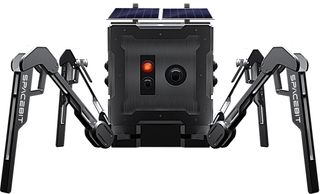
Spiders on the Moon: 'Walking' Robots Will Explore Lunar Crevices and Caves
Spacebit's moon robots could launch in 2021.
WASHINGTON – Spacebit's creepy-crawly robots could soon help explore the mysterious caves and lava tubes on the moon, according to the company's CEO. And the first test mission is expected to fly in 2021.
Spacebit CEO Pavlo Tanasyuk made an energetic appearance before delegates at the International Astronautical Congress here on Oct. 24 in the wake of two major announcements from his company this month. On Oct. 10, Spacebit announced its plans to launch the United Kingdom's first privately built moon rover in 2021. Then on Oct. 23, the company entered a new partnership with the International Astronautical Federation Regional Group for Latin America and the Caribbean.
This is all big news for a startup that is joining the rush of missions toward the moon, helped in no small part by NASA's pledge to land humans on the surface in 2024. NASA is already encouraging private companies to participate through its Commercial Lunar Payload Services (CLPS) program, and other companies are coming aboard.
Video: UK's Moon Rovers Have Legs, Look a Little Creepy
Related: NASA Wants Robots to Sniff Out Moon Pits for Astronaut Homes

Spacebit's offering is robots with legs, which would allow the machines to delve into cracks and crevices inaccessible to traditional space rovers. The mission design calls for a rover to bring as many as eight such robots to a drop-off point. Then they would leave the "mothership" and in a swarm, explore lunar caves using artificial intelligence to bring back more details about the moon's history. "We don't have wheels – we have four legs instead of the wheels – which is a very neat design" for this type of work, Tanasyuk said at the International Astronautical Conference on Oct. 24.
The London-based company intends to launch the first batch of these rovers together with Astrobotic's Peregrine moon lander, which is scheduled to launch on a United Launch Alliance Vulcan Centaur rocket in July 2021. This would be the first mission for both the lander and the Vulcan Centaur rocket, so "we're really hoping they make the landing," Tanasyuk said. If this goes according to plan, Peregrine's landing will make it possible for Spacebit to achieve its own exploration "first" – to be the company that sends the first legged robot to explore another world.

Tanasyuk has a larger vision to make space exploration more accessible. Spacebit's robots are built on a single-unit cubesat frame that is usually used for tiny satellites. Individual robots only weigh a bit more than 3 lbs. (1.5 kilograms) each, which is an order of magnitude less massive than the Chinese Yutu rover at 265 lbs. (120 kg).
Get the Space.com Newsletter
Breaking space news, the latest updates on rocket launches, skywatching events and more!
The robots, which cost $3 million each, are expected to be built in only six to 12 months (which is much more rapid than the traditional years-long schedule of spacecraft construction). "We could have multiple rovers exploring the moon, and [its] lava tubes, and even going beyond in the future," Tanasyuk said.
His plans for the business include selling the technology to interested customers, including universities and other space agencies. With the missions using standardized equipment and off-the-shelf components, Tanasyuk added, space exploration will be more affordable, and that will encourage more entities to fly to the moon. "After 50 years' absence of humans on the moon, I believe that robotic missions will play a very major role in our comeback," he said.
- Japan's 1st Moon Rover to Touch Down in 2021
- Europe Wants Ideas for Cave-Spelunking Moon Robots. Here's How You Can Help!
- Incredible Technology: Spiderlike Robots Could Build Giant Space Structures
Follow Elizabeth Howell on Twitter @howellspace. Follow us on Twitter @Spacedotcom and on Facebook.
Join our Space Forums to keep talking space on the latest missions, night sky and more! And if you have a news tip, correction or comment, let us know at: community@space.com.

Elizabeth Howell (she/her), Ph.D., is a staff writer in the spaceflight channel since 2022 covering diversity, education and gaming as well. She was contributing writer for Space.com for 10 years before joining full-time. Elizabeth's reporting includes multiple exclusives with the White House and Office of the Vice-President of the United States, an exclusive conversation with aspiring space tourist (and NSYNC bassist) Lance Bass, speaking several times with the International Space Station, witnessing five human spaceflight launches on two continents, flying parabolic, working inside a spacesuit, and participating in a simulated Mars mission. Her latest book, "Why Am I Taller?", is co-written with astronaut Dave Williams. Elizabeth holds a Ph.D. and M.Sc. in Space Studies from the University of North Dakota, a Bachelor of Journalism from Canada's Carleton University and a Bachelor of History from Canada's Athabasca University. Elizabeth is also a post-secondary instructor in communications and science at several institutions since 2015; her experience includes developing and teaching an astronomy course at Canada's Algonquin College (with Indigenous content as well) to more than 1,000 students since 2020. Elizabeth first got interested in space after watching the movie Apollo 13 in 1996, and still wants to be an astronaut someday. Mastodon: https://qoto.org/@howellspace
